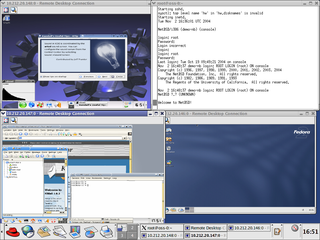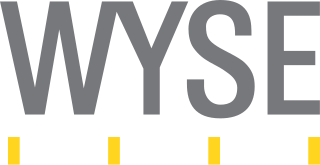
Silicon Graphics, Inc. was an American high-performance computing manufacturer, producing computer hardware and software. Founded in Mountain View, California in November 1981 by Jim Clark, its initial market was 3D graphics computer workstations, but its products, strategies and market positions developed significantly over time.

In computer networking, a thin client is a simple (low-performance) computer that has been optimized for establishing a remote connection with a server-based computing environment. They are sometimes known as network computers, or in their simplest form as zero clients. The server does most of the work, which can include launching software programs, performing calculations, and storing data. This contrasts with a rich client or a conventional personal computer; the former is also intended for working in a client–server model but has significant local processing power, while the latter aims to perform its function mostly locally.

Citrix Systems, Inc. is an American multinational cloud computing and virtualization technology company that provides server, application and desktop virtualization, networking, software as a service (SaaS), and cloud computing technologies. Citrix products were claimed to be in use by over 400,000 clients worldwide, including 99% of the Fortune 100, and 98% of the Fortune 500.

VMware, Inc. is an American cloud computing and virtualization technology company with headquarters in Palo Alto, California. VMware was the first commercially successful company to virtualize the x86 architecture.

Xen is a type-1 hypervisor, providing services that allow multiple computer operating systems to execute on the same computer hardware concurrently. It was originally developed by the University of Cambridge Computer Laboratory and is now being developed by the Linux Foundation with support from Intel, Citrix, Arm Ltd, Huawei, AWS, Alibaba Cloud, AMD, Bitdefender and epam.
Wind River Systems, also known as Wind River, is an Alameda, California–based company, subsidiary of Aptiv PLC. The company develops embedded system and cloud software consisting of real-time operating systems software, industry-specific software, simulation technology, development tools and middleware.
Operating systems based on the Linux kernel are used in embedded systems such as consumer electronics, in-vehicle infotainment (IVI), networking equipment, machine control, industrial automation, navigation equipment, spacecraft flight software, and medical instruments in general.

A diskless node is a workstation or personal computer without disk drives, which employs network booting to load its operating system from a server.

Citrix Online was the name of the online services division of Citrix Systems. Citrix Online sold web-based remote access, support, and collaboration software and services. Its products are GoToAssist, GoToMeeting, GoToMyPC, GoToTraining, GoToWebinar, Podio, and OpenVoice. Citrix Online used the software as a service (SaaS) and application service provider (ASP) software business models.
The following is a timeline of virtualization development. In computing, virtualization is the use of a computer to simulate another computer. Through virtualization, a host simulates a guest by exposing virtual hardware devices, which may be done through software or by allowing access to a physical device connected to the machine.

M-Systems Ltd., was a Nasdaq-listed Israeli producer of flash memory storage products founded in 1989 by Dov Moran and Aryeh Mergi, based in Kfar Saba, Israel. They were best known for developing and patenting the first flash drive, marketed in 1995 as DiskOnChip, and the first USB flash drive, marketed in 2000 as DiskOnKey. They also created the patented True Flash Filing System (TrueFFS) which presented the flash memory as a disk drive to the computer. After 17 years of business, they were acquired by their prior competitor, SanDisk, in 2006. The DiskOnChip (DOC) was developed at the R&D Center established by M-Systems called EUROM. Rick Iorillo, Rony Levy and David Deitcher were the individuals that worked on the development and marketing of the first 2 MB DOC. This product went on to receive the Most Innovative Award from EDN in 1995 and later went on to become the Flash Drive and DiskOnKey.

ShareFile is a secure content collaboration, file sharing and sync software that supports all the document-centric tasks and workflow needs of small and large businesses. The company also offers cloud-based or on-premises storage, virtual data rooms and client portals. ShareFile is owned by Citrix Systems.
IntervalZero, Inc. develops hard real-time software and its symmetric multiprocessing (SMP) enabled RTX and RTX64 software transform the Microsoft Windows general-purpose operating system (GPOS) into a real-time operating system (RTOS).

Dell Compellent, formerly Compellent Technologies, Inc., was an American manufacturer of enterprise computer data storage systems that provided block-level storage resources to small and medium sized IT infrastructures. The company was founded in 2002 and headquartered in Eden Prairie, Minnesota. Compellent's flagship product, Storage Center, is a storage area network (SAN) system that combines a standards-based hardware platform and a suite of virtualized storage management applications, including automated tiered storage through a proprietary process called "DataProgression", thin provisioning and replication. The company developed software and products aimed at mid-size enterprises and sold through a channel network of independent providers and resellers. It became part of Dell in February 2011.

Datalight was a privately held software company specializing in power failsafe and high performance software for preserving data integrity in embedded systems. The company was founded in 1983 by Roy Sherrill, and is headquartered in Bothell, Washington. As of 2019 the company is a subsidiary of Tuxera under the name of Tuxera US Inc.

Wyse Technology, often shortened to Wyse, was an independent American manufacturer of cloud computing systems. As of 2012, Wyse is a subsidiary of Dell. Wyse are best remembered for their video terminal line introduced in the 1980s, which competed with the market-leading Digital. They also had a successful line of IBM PC compatible workstations in the mid-to-late 1980s. But starting late in the decade, Wyse were outcompeted by companies such as eventual parent Dell. Current products include thin client hardware and software as well as desktop virtualization solutions. Other products include cloud software-supporting desktop computers, laptops, and mobile devices. Dell Cloud Client Computing is partnered with IT vendors such as Citrix, IBM, Microsoft, and VMware.

ZENworks, a suite of software products developed and maintained by Micro Focus International for computer systems management, aims to manage the entire life cycle of servers, of desktop PCs, of laptops, and of handheld devices such as Android and iOS mobile phones and tablets. As of 2011 Novell planned to include Full Disk Encryption (FDE) functionality within ZENworks. ZENworks supports multiple server platforms and multiple directory services.
Software-defined storage (SDS) is a marketing term for computer data storage software for policy-based provisioning and management of data storage independent of the underlying hardware. Software-defined storage typically includes a form of storage virtualization to separate the storage hardware from the software that manages it. The software enabling a software-defined storage environment may also provide policy management for features such as data deduplication, replication, thin provisioning, snapshots and backup.
Tuxera Inc. is a Finnish software company that develops and sells file systems software. Its most popular products are Tuxera NTFS and Tuxera exFAT, both available on a number of platforms including Linux, Android, QNX and macOS. Tuxera's customers include a number of consumer electronics manufacturers in mobile phones, tablets, TVs, set-top boxes, automotive infotainment and storage markets. Tuxera NTFS for Mac provides read/write connectivity to Windows-formatted hard drives for macOS.












